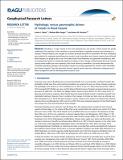Hydrologic versus geomorphic drivers of trends in flood hazard
Abstract
Flooding is a major hazard to lives and infrastructure, but trends in flood hazard are poorly understood. The capacity of river channels to convey flood flows is typically assumed to be stationary, so changes in flood frequency are thought to be driven primarily by trends in streamflow. We have developed new methods for separately quantifying how trends in both streamflow and channel capacity have affected flood frequency at gauging sites across the USA. Flood frequency was generally nonstationary, with increasing flood hazard at a statistically significant majority of sites. Channel capacity driven changes in flood hazard were smaller, but more numerous, than those driven by streamflow. Our results demonstrate that accurately quantifying changes in flood hazard requires accounting separately for trends in both streamflow and channel capacity. They also show that channel capacity trends may have unforeseen consequences for flood management and for estimating flood insurance costs.
Citation
Slater , L J E , Singer , M B & Kirchner , J 2015 , ' Hydrologic versus geomorphic drivers of trends in flood hazard ' , Geophysical Research Letters , vol. 42 , no. 2 , pp. 370-376 . https://doi.org/10.1002/2014GL062482
Publication
Geophysical Research Letters
Status
Peer reviewed
ISSN
0094-8276Type
Journal article
Description
This work was partially supported by a NERC studentship to LJSCollections
Items in the St Andrews Research Repository are protected by copyright, with all rights reserved, unless otherwise indicated.

